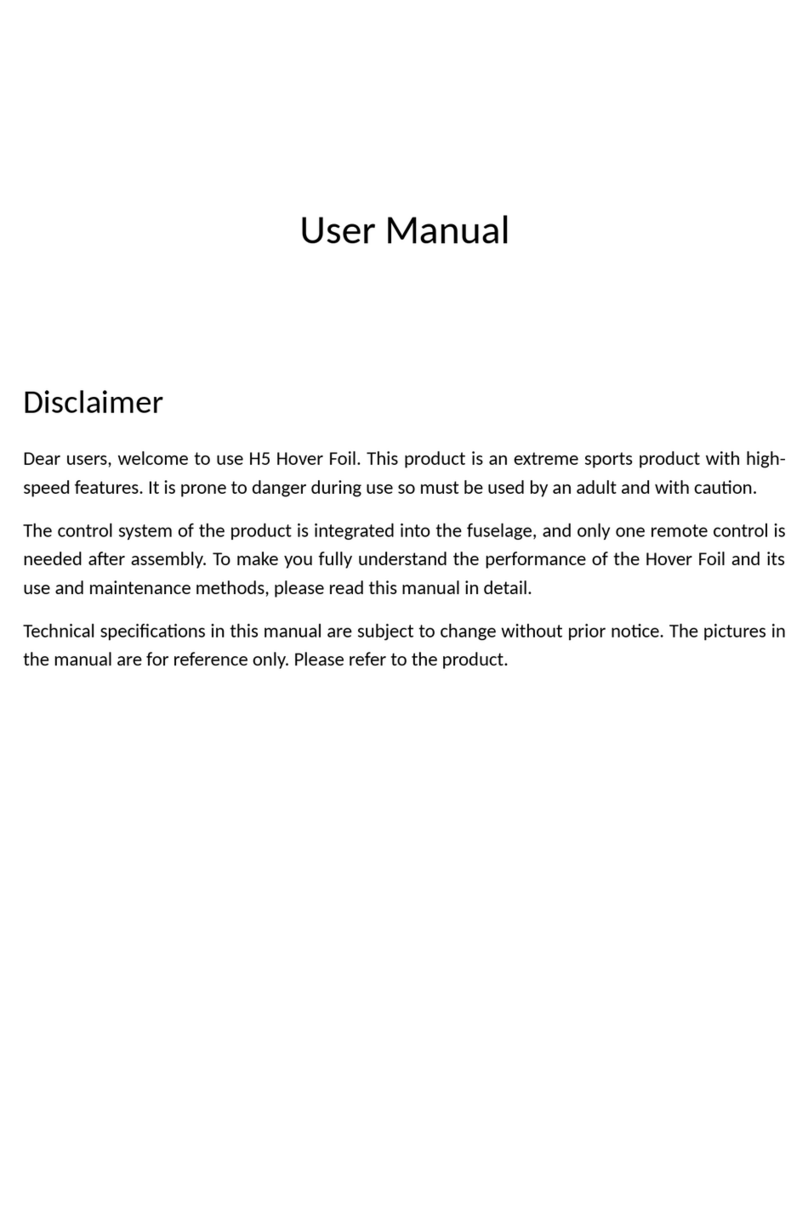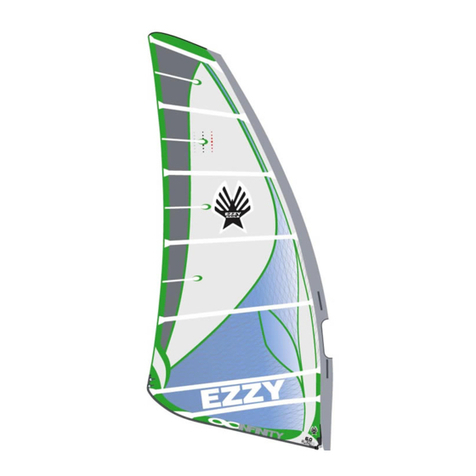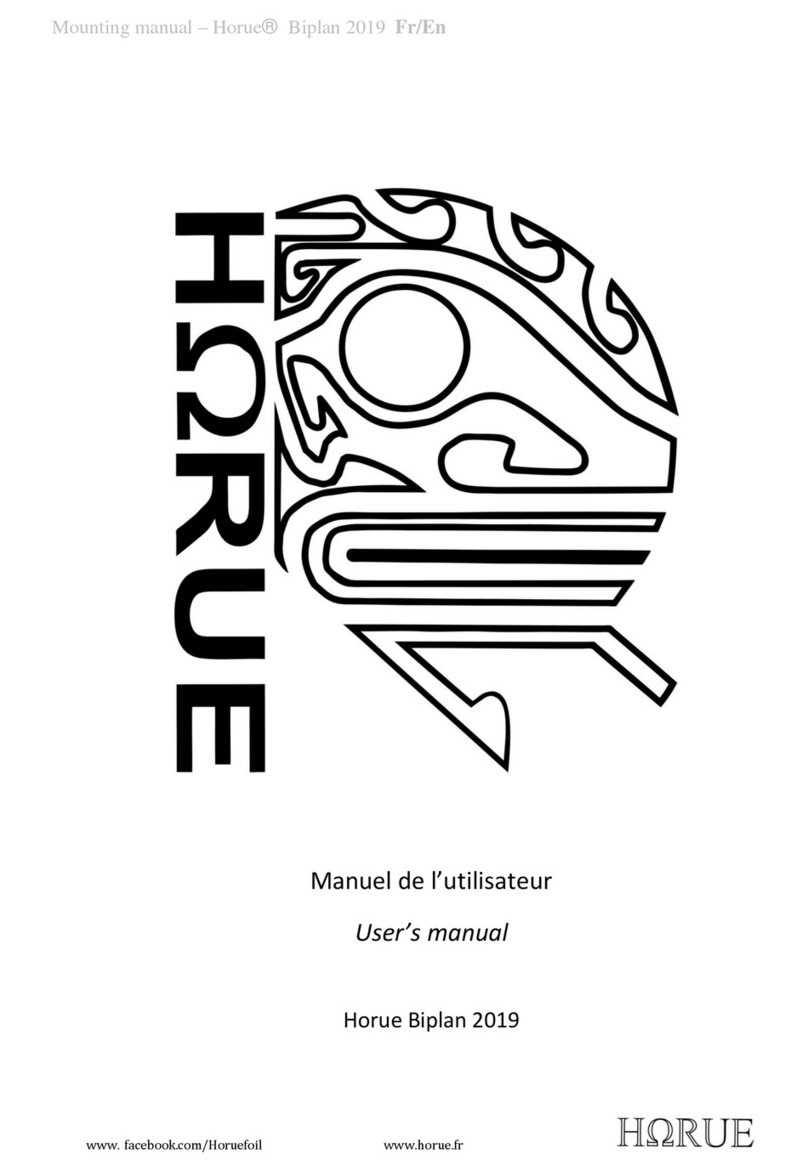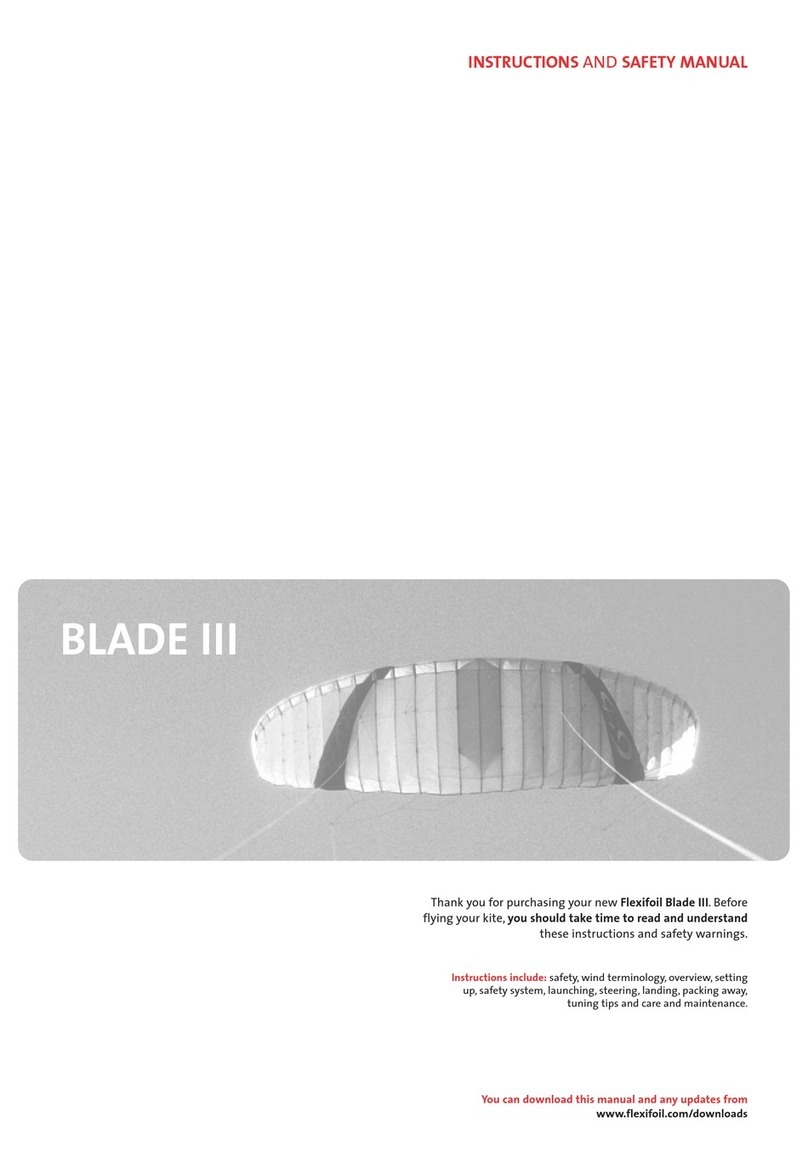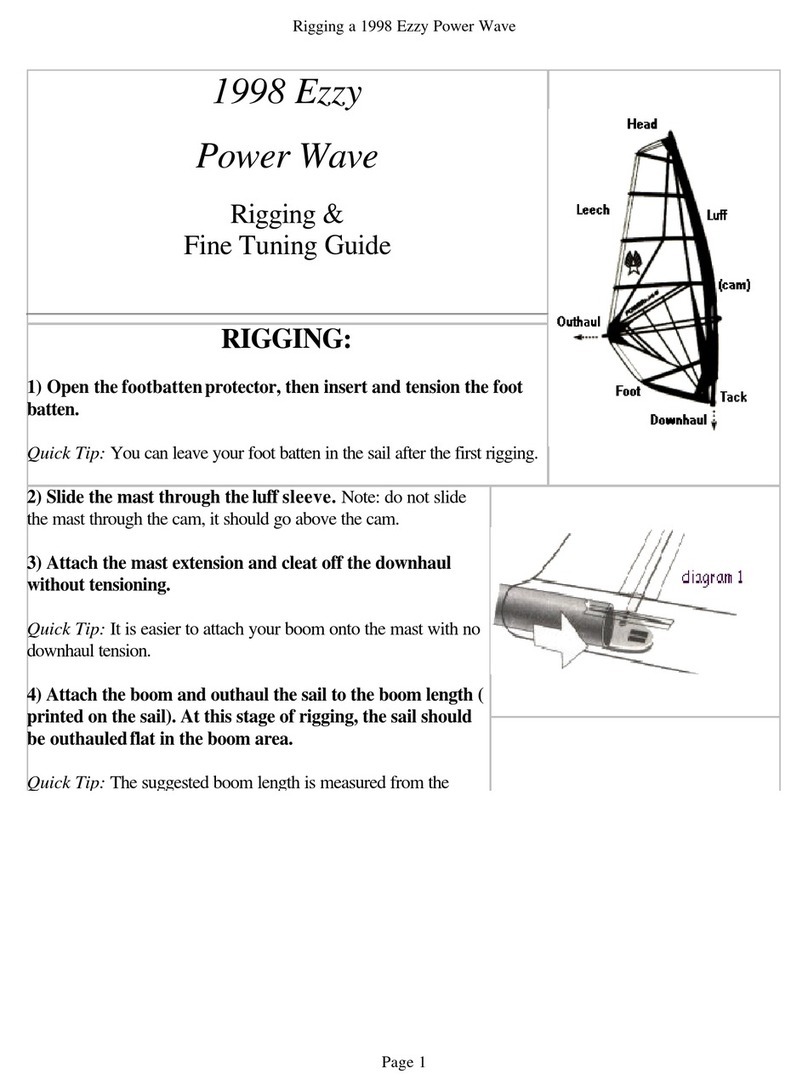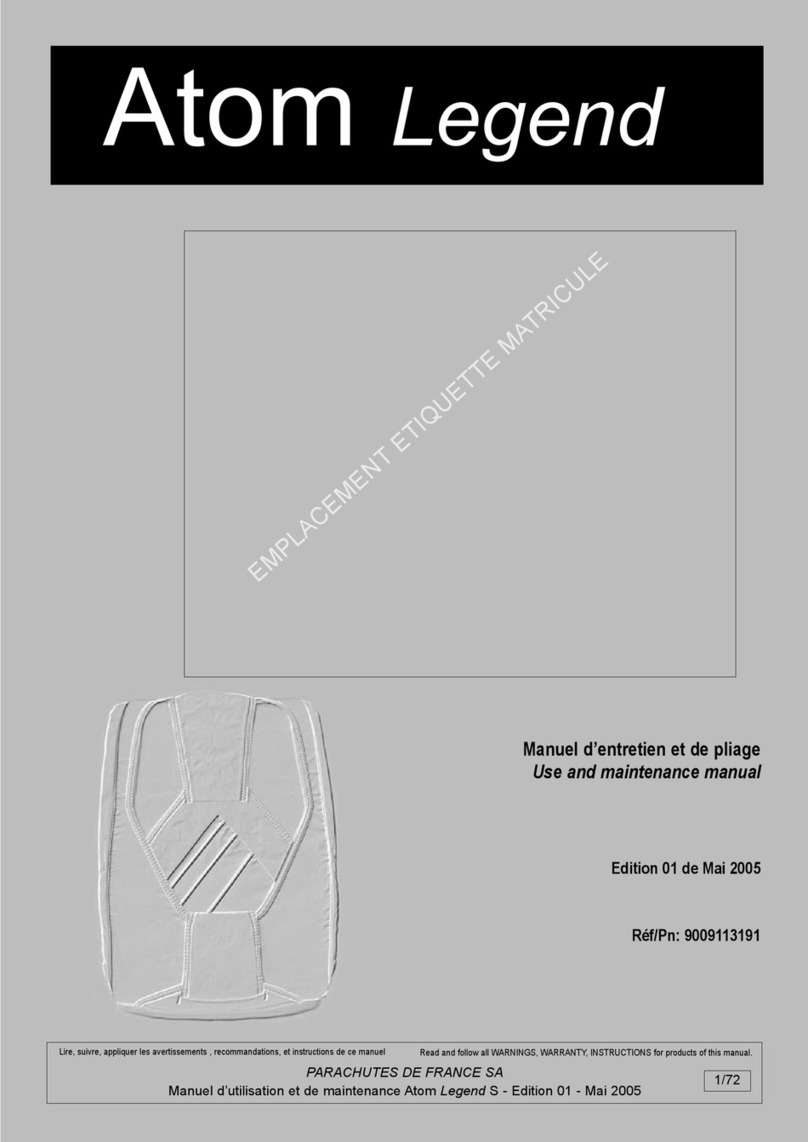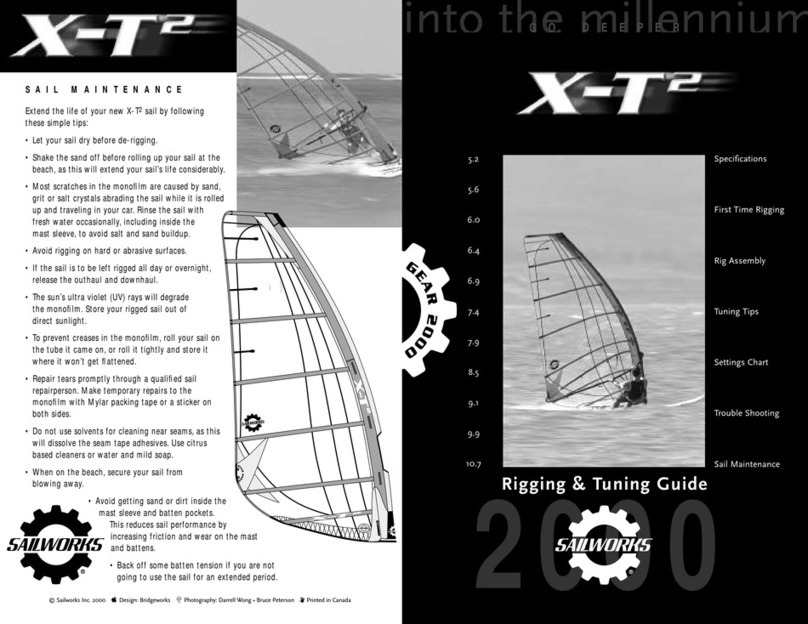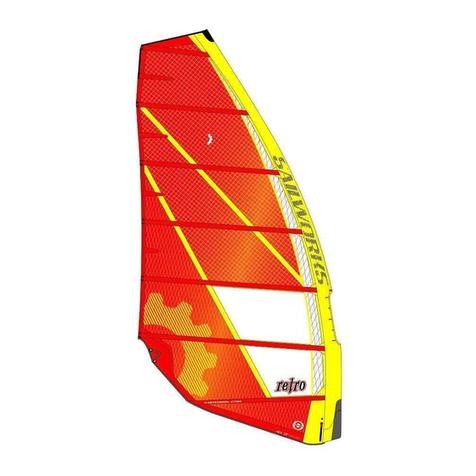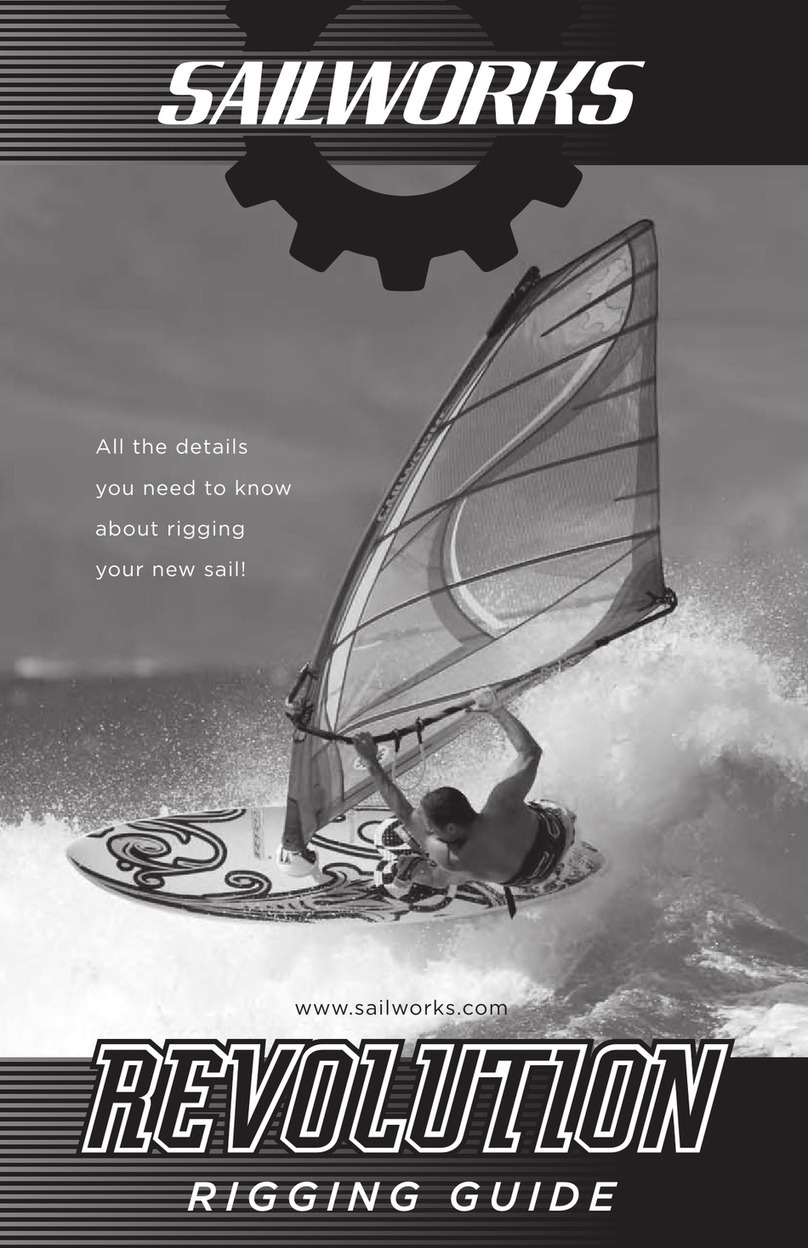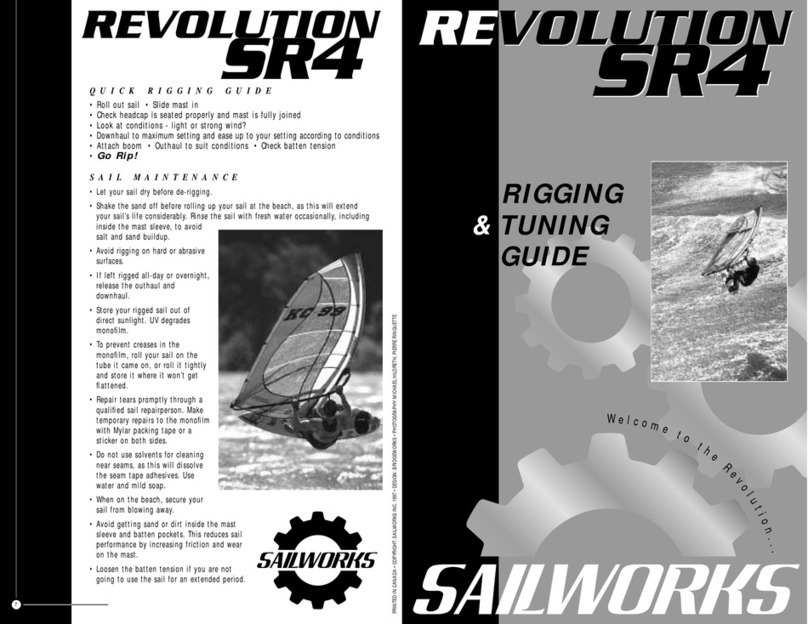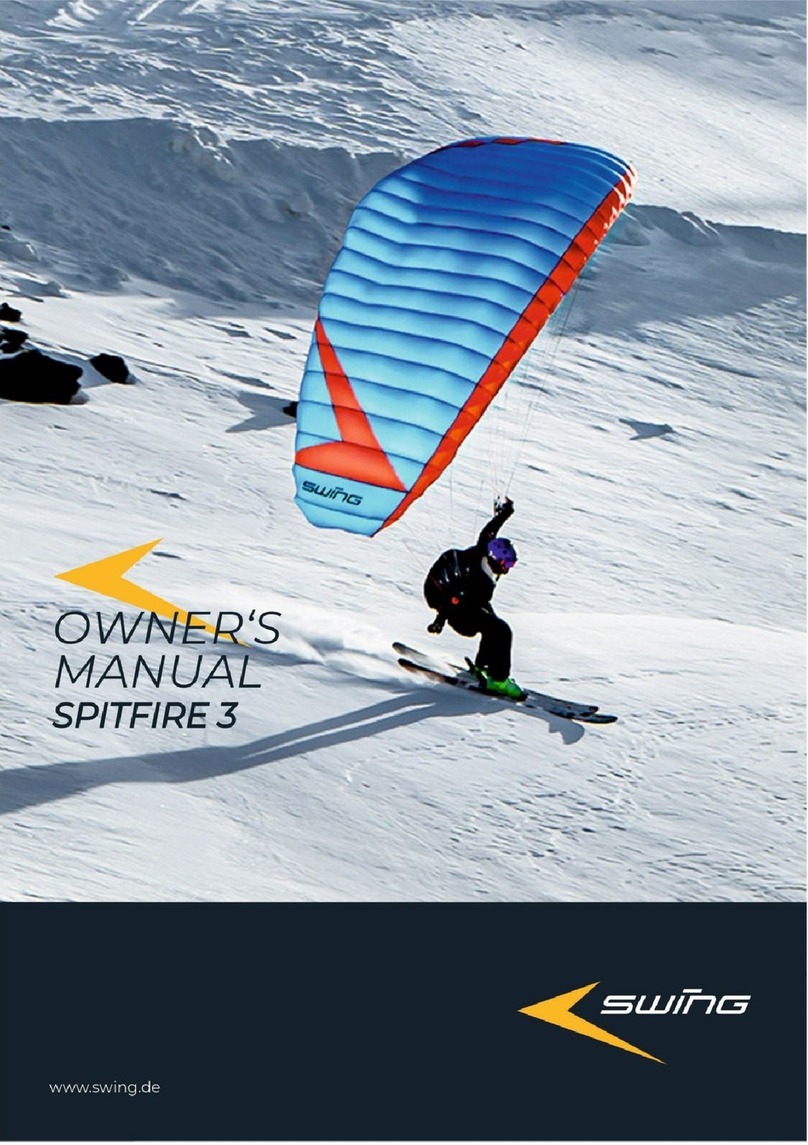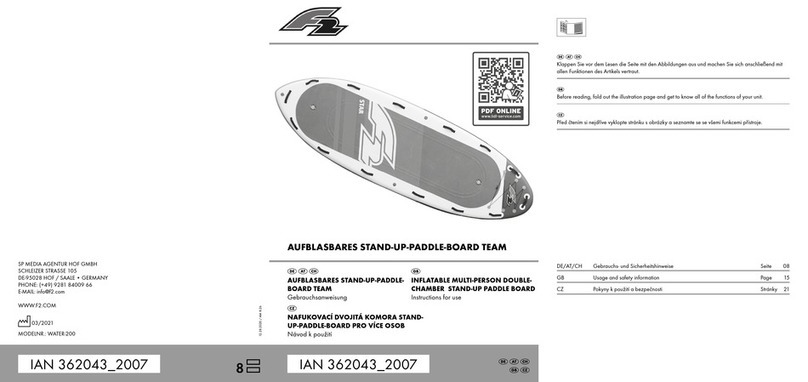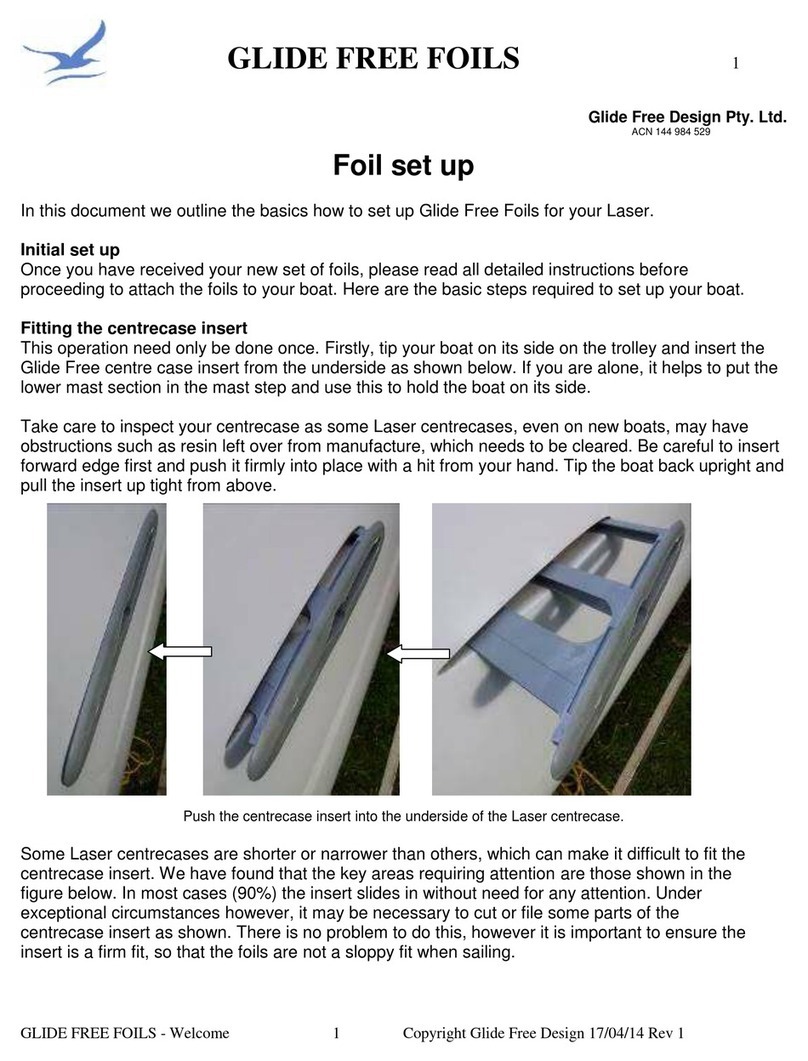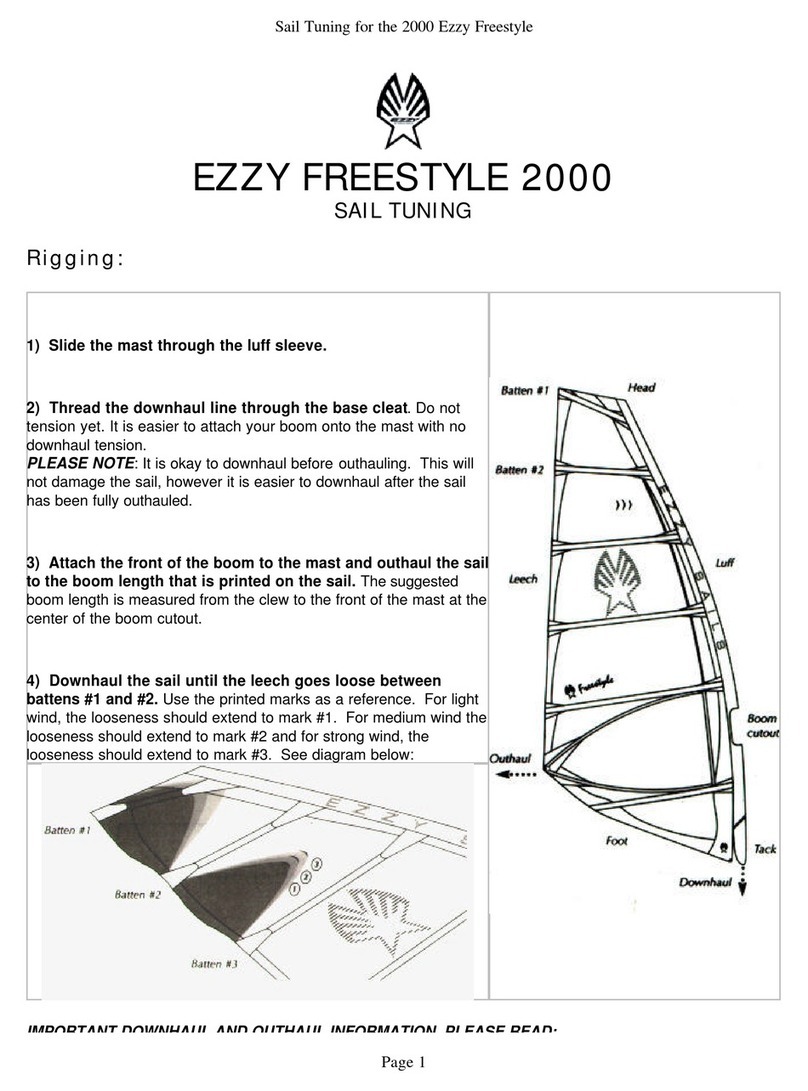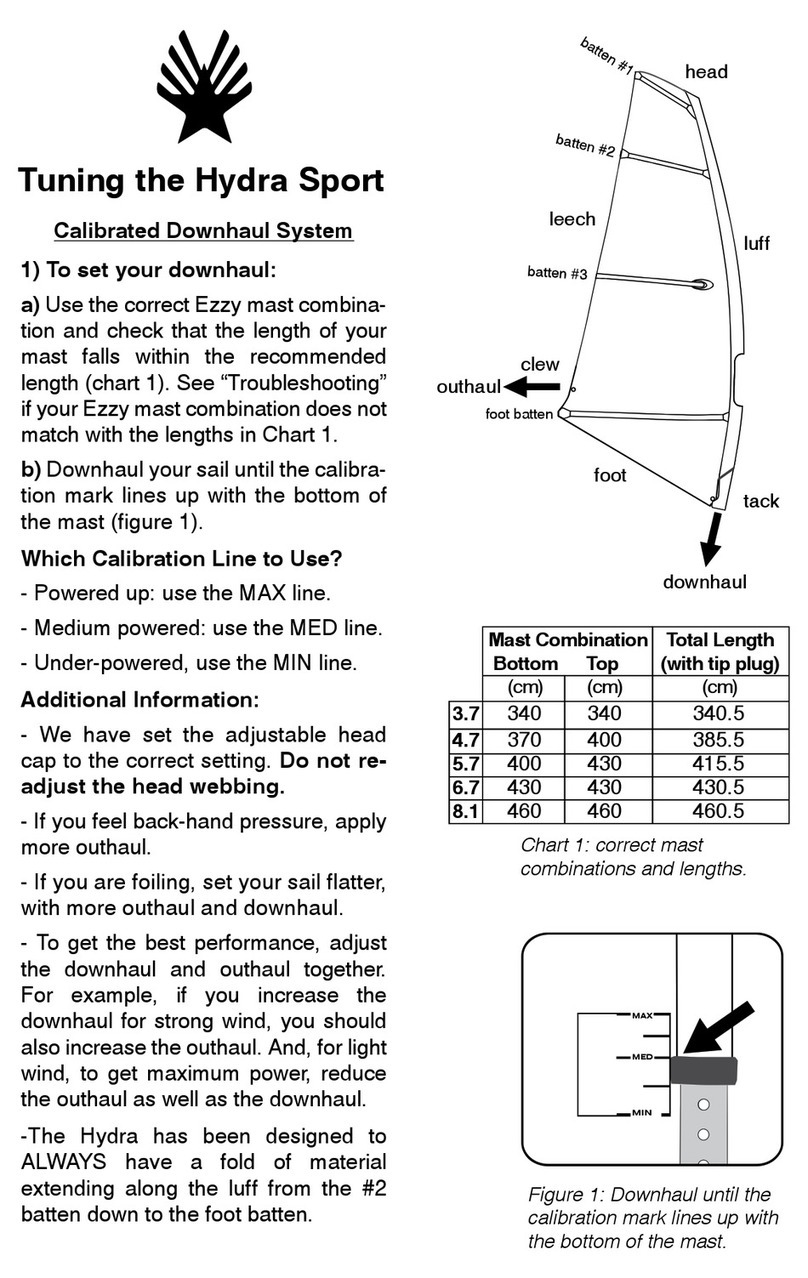3
5 TENSION THE SBT’S
(Streamlined Batten Tensioners)
The battens are tensioned using the hex-key tool
found under the strap above the tack handle.
Insert the hex-key into the cap screw inside the
SBT at the leech end of each batten. Turn the
hex-key to the right (clockwise) to tighten.
Tension the battens
JUST until the
wrinkles across the
batten pockets
disappear. Look for a
continuous smooth
shape to the sailcloth
next to the batten
pocket (see photos). You should see a smooth
reflection, with no wrinkles in the sailcloth
alongside the battens. CAUTION: DO NOT OVER-TENSION THE BATTENS - POOR ROTATION,
EXCESSIVE FOIL DEPTH AND DAMAGE TO THE SAIL CAN RESULT. Replace the hex-key tool
back in its pocket above the tack handle. Once the batten tension is set, it’s not necessary
to adjust it for each session. Set it and forget it!
6 BALANCING THE OUTHAUL SETTING
Release any outhaul tension and allow the sail to relax naturally. Now pull the outhaul a
minimum of 3.0 cm (1 1/4 inch) from this neutral position. Check the foil depth by pushing
on the sail area under your harness lines or standing it up in the wind. Under pressure, the
sail will increase in depth as the battens pull back from the mast. When luffing or without
pressure, the sail will flatten. Less outhaul makes the sail fuller and more powerful for
reaching, but it will also be harder to control when over-powered or sailing upwind. For
upwind sailing or over-powered conditions, more outhaul tension will improve performance
by making the sail flatter and tighter. Whenever you increase or release downhaul, realize
that the outhaul tension has also changed and may need to be adjusted too.
TUNING FOR WIND RANGE
Please refer to the RETRO Settings Chart on pages 5 & 6.
Light wind (under-powered conditions)
• Less downhaul, to increase foil
depth for more power; to tighten
the leech for better pumping; and
to reduce twist and increase power
in the upper part of the sail.
• Less outhaul, for more depth.
A looser outhaul moves the center
of effort (power) further back,
which facilitates early planing.
High wind (over-powering conditions)
• More downhaul, to tighten and
flatten the leading edge of the sail.
This lowers the center of effort and
gives the sail more twist.
• More outhaul, to flatten the overall
foil depth and reduce power. This will
tighten the sail and improve top end
handling and control.
RIG ASSEMBLY
1 INSERT THE MAST
Pull the sail down the mast in sections using the tack handle and working the mast tip to
the top of the sleeve before pulling the tack all the way down to the base of the mast. Try to
keep the battens all rotated to the under-side of the mast. Check that the headcap is seated
completely onto the mast and that the two-piece coupling of the mast is joined completely
before downhauling.
2 INSERT THE MAST BASE
Estimate the amount of mast base extension needed by subtracting your mast length from the
sail’s luff length. Your downhaul pulley system should have 6:1 purchase and enough line to
make lacing easy. Lace the downhaul line through the Power Block tack pulley. Keep the line
looping in the same direction each time you feed it through the Power Block and through your
base pulley (we recommend counter-clockwise working from the underside upwards. Try not to
cross the lines, as this increases friction and makes the downhaul harder to pull. Do not fully
downhaul the sail yet - leave the downhaul just “hand-tight”.
3 ATTACH THE BOOM
If you plan to use the on-the-fly adjustable outhaul system enclosed, set that up now.
Follow the instructions enclosed with the adjustable outhaul for setup and use. Adjust
your boom to the length specified for the sail. Attach the boom to the mast at the middle
of the opening and re-adjust it after the sail is fully rigged. Be careful not to attach if too
high in the boom opening - you must account for the sail to be downhauled further. Also be
careful not to pinch the mast sleeve under the boom clamp. Lace the outhaul through the
clew grommet, and pull the outhaul completely so the sail is flat, using the recommended
boom length.
4 TUNING THE DOWNHAUL
The downhaul controls the sail’s shape and performance. Discover its effect by pulling and
slowly releasing the line. Use an easy-rig or downhauling tool so the line is easier to pull
hard. Watch the change in depth and tension of the leading edge (front 1/3 of the sail),
and the flattening and loosening of the head area (upper leech) as more downhaul is pulled.
Specifically notice the change in the angles, or twist, of the battens; the top batten should
open to leeward the furthest-called “progressive twist”. Twist is cut into the sail, but is
ultimately controlled by the downhaul tension. More downhaul induces more twist; less
downhaul allows less twist. Twist improves sail efficiency by lowering the center of effort
and making the sail easier to control.
The optimum downhaul setting gives a tight luff and a lean (not full) entry, and the leech
area between the top two battens should become loose (see RETRO Settings Chart). A good
reference point is the curved leech seam between the top two battens. If the looseness falls
short of this seam from the leech side, you will have the minimum setting. If the looseness
extends forward past the seam, you will have the maximum setting. This looseness is normal
and is necessary to allow the sail to twist open properly.
Once you’re familiar with the correct downhaul setting, re-check the headcap length vs. mast
base height. If necessary, re-adjust these so that the Power Block tack pulley sits very close
to the mast base cleat, and the amount of mast extending out the top of the mast sleeve is
minimized by lowering the mast base.
4
Needs more batten tension
Correct batten tension
